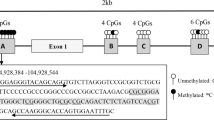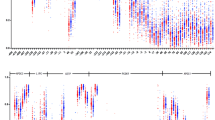Abstract
Background
ATP-binding cassette transporters A1/G1 (ABCA1/G1) is a main regulator of HDL (high-density lipoprotein) formation and reverse cholesterol transport. Impaired ABCA1/G1 genes function may seriously affect cholesterol homeostasis, leading to increased risk of cardiovascular disease. In the present study, the association of ABCA1/G1 genes methylation status with the risk of coronary artery disease (CAD), risk factors of CAD, and serum level of lipid parameters was investigated.
This study was conducted on 70 CAD patients and 40 control subjects. All CAD subjects with diabetes mellitus were excluded. The promoter methylation status of ABCA1/G1 genes was determined by the methylation-specific polymerase chain reaction (MS-PCR) method and serum lipid parameters were assessed using commercial kits.
Results
ABCA1 promoter methylation was higher in CAD group compared to the control participants (80% vs. 60%). Hypermethylation of the ABCA1 gene significantly increases the risk of CAD in the total population (OR 3.886, 95% CI (1.181–12.791), p = 0.026). ABCG1 methylation status showed no difference between CAD and control subjects. In addition, no significant association was noted between methylation status of ABCA1/G1 and serum level of lipid profile.
Conclusions
Altogether, our study shows that ABCA1 gene promoter hypermethylation may increase the risk of CAD, which may help identify people at risk of develo** CAD.
Similar content being viewed by others
Introduction
Coronary artery disease (CAD), the most common form of cardiovascular disease (CVD), is one of the main causes of mortality and morbidity worldwide [1]. Atherosclerosis, the leading cause of CAD, is a chronic inflammatory disorder with lipid deposition in coronary arteries that in turn develop angina pectoris, myocardial infarction (MI), and death [2].
Genetic and environmental factors such as poor diet, a family history of CAD, aging, smoking, hypertension, diabetes, and dyslipidemia are considered as risk factors for CAD. Dyslipidemia, as a key predictor of atherosclerotic cardiovascular disease, is defined as an increase in plasma total cholesterol (TC), triglyceride (TG), low-density lipoprotein-cholesterol (LDL-C), and decrease in high-density lipoprotein-cholesterol (HDL-C) [3]. CAD is treated mainly through lifestyle changes, such as exercising, eating a healthy diet, and controlling body weight. In some cases, the use of drugs that lower cholesterol and blood pressure, as well as beta blockers and aspirin are also prescribed [4].
The inverse association between HDL-C and CVD risk is well established [ The data are available from the corresponding author on reasonable request. ATP-binding cassette transporters A1/G1 Coronary artery disease Methylation-specific polymerase chain reaction Cardiovascular disease Myocardial infarction Total cholesterol Triglyceride Low-density lipoprotein-cholesterol High-density lipoprotein-cholesterol Apolipoprotein A1 ATP-binding cassette Familial hypercholesterolemia WHO (World Health Organ) (2017) Cardiovascular Diseases (CVDs). https://www.who.int/news-room/factsheets/detail/cardiovascular-diseases-(cvds). Accessed 20 Feb 2022 Bakshi C, Vijayvergiya R, Dhawan V (2019) Aberrant DNA methylation of M1-macrophage genes in coronary artery disease. Sci Rep 9:1429. https://doi.org/10.1038/s41598-018-38040-1 Kopin L, Lowenstein C (2017) Dyslipidemia. Ann Intern Med 167:ITC81–ITC96. https://doi.org/10.7326/AITC201712050 Jia S, Liu Y, Yuan J (2020) Evidence in guidelines for treatment of coronary artery disease. Adv Exp Med Biol 1177:37–73. https://doi.org/10.1007/978-981-15-2517-9_2 Casula M, Colpani O, **e S, Catapano AL, Baragetti A (2021) HDL in atherosclerotic cardiovascular disease: in search of a role. Cells 10:1869. https://doi.org/10.3390/cells10081869 Tuteja S, Rader DJ (2014) High-density lipoproteins in the prevention of cardiovascular disease: changing the paradigm. Clin Pharmacol Ther 96:48–56. https://doi.org/10.1038/clpt.2014.79 Yu XH, Tang CK (2022) ABCA1, ABCG1, and cholesterol homeostasis. Adv Exp Med Biol 1377:95–107. https://doi.org/10.1007/978-981-19-1592-5_7 Ren K, Li H, Zhou HF, Liang Y, Tong M, Chen L et al (2019) Mangiferin promotes macrophage cholesterol efflux and protects against atherosclerosis by augmenting the expression of ABCA1 and ABCG1. Aging (Albany NY) 11:10992–11009. https://doi.org/10.18632/aging.102498 Schumacher T, Benndorf RA (2017) ABC transport proteins in cardiovascular disease-a brief summary. Molecules 22:589. https://doi.org/10.3390/molecules22040589 Kämmerer I, Ringseis R, Biemann R, Wen G, Eder K (2011) 13-hydroxy linoleic acid increases expression of the cholesterol transporters ABCA1, ABCG1 and SR-BI and stimulates apoA-I-dependent cholesterol efflux in RAW264.7 macrophages. Lipids Health Dis 10:222. https://doi.org/10.1186/1476-511X-10-222 Babashamsi MM, Koukhaloo SZ, Halalkhor S, Salimi A, Babashamsi M (2019) ABCA1 and metabolic syndrome; a review of the ABCA1 role in HDL-VLDL production, insulin-glucose homeostasis, inflammation and obesity. Diabetes Metab Syndr 13:1529–1534. https://doi.org/10.1016/j.dsx.2019.03.004 Uehara Y, Saku K (2014) High-density lipoprotein and atherosclerosis: roles of lipid transporters. World J Cardiol 6:1049–1059. https://doi.org/10.4330/wjc.v6.i10.1049 Wang N, Tall AR (2003) Regulation and mechanisms of ATP-binding cassette transporter A1-mediated cellular cholesterol efflux. Arterioscler Thromb Vasc Biol 23:1178–1184. https://doi.org/10.1161/01.ATV.0000075912.83860.26 Walldius G, Jungner I (2004) Apolipoprotein B and apolipoprotein A-I: risk indicators of coronary heart disease and targets for lipid-modifying therapy. J Intern Med 255:188–205. https://doi.org/10.1046/j.1365-2796.2003.01276.x Walldius G, Jungner I (2005) Rationale for using apolipoprotein B and apolipoprotein A-I as indicators of cardiac risk and as targets for lipid-lowering therapy. Eur Heart J 26:210–212. https://doi.org/10.1093/eurheartj/ehi077 Behbodikhah J, Ahmed S, Elyasi A, Kasselman LJ, De Leon J, Glass AD et al (2021) Apolipoprotein B and cardiovascular disease: biomarker and potential therapeutic target. Metabolites 11:690. https://doi.org/10.3390/metabo11100690 Prasher D, Greenway SC, Singh RB (2020) The impact of epigenetics on cardiovascular disease. Biochem Cell Biol 98:12–22. https://doi.org/10.1139/bcb-2019-0045 Duan L, Hu J, **ong X, Liu Y, Wang J (2018) The role of DNA methylation in coronary artery disease. Gene 646:91–97. https://doi.org/10.1016/j.gene.2017.12.033 Guay SP, Brisson D, Munger J, Lamarche B, Gaudet D, Bouchard L (2012) ABCA1 gene promoter DNA methylation is associated with HDL particle profile and coronary artery disease in familial hypercholesterolemia. Epigenetics 7:464–472. https://doi.org/10.4161/epi.19633 Sharma P, Garg G, Kumar A, Mohammad F, Kumar SR, Tanwar VS et al (2014) Genome wide DNA methylation profiling for epigenetic alteration in coronary artery disease patients. Gene 541:31–40. https://doi.org/10.1016/j.gene.2014.02.034 Ghaznavi H, Mahmoodi K, Soltanpour MS (2018) A preliminary study of the association between the ABCA1 gene promoter DNA methylation and coronary artery disease risk. Mol Biol Res Commun 7:59–65. https://doi.org/10.22099/mbrc.2018.28910.1312 Guay SP, Légaré C, Houde AA, Mathieu P, Bossé Y, Bouchard L (2014) Acetylsalicylic acid, aging and coronary artery disease are associated with ABCA1 DNA methylation in men. Clin Epigenetics 6:14. https://doi.org/10.1186/1868-7083-6-14 Raciti GA, Desiderio A, Longo M, Leone A, Zatterale F, Prevenzano I et al (2021) DNA methylation and type 2 diabetes: novel biomarkers for risk assessment? Int J Mol Sci 22:11652. https://doi.org/10.3390/ijms222111652 Walaszczyk E, Luijten M, Spijkerman AMW, Bonder MJ, Lutgers HL, Snieder H et al (2018) DNA methylation markers associated with type 2 diabetes, fasting glucose and HbA1c levels: a systematic review and replication in a case-control sample of the Lifelines study. Diabetologia 61:354–368. https://doi.org/10.1007/s00125-017-4497-7 Cardona A, Day FR, Perry JRB, Loh M, Chu AY, Lehne B et al (2019) Epigenome-wide association study of incident type 2 diabetes in a British population: EPIC-Norfolk study. Diabetes 68:2315–2326. https://doi.org/10.2337/db18-0290 Peng P, Wang L, Yang X, Huang X, Ba Y, Chen X et al (2014) A preliminary study of the relationship between promoter methylation of the ABCG1, GALNT2 and HMGCR genes and coronary heart disease. PLoS ONE 9:e102265. https://doi.org/10.1371/journal.pone.0102265 Kerner W, Brückel J (2014) German Diabetes Association. Definition, classification and diagnosis of diabetes mellitus. Exp Clin Endocrinol Diabetes 122:384–386. https://doi.org/10.1055/s-0034-1366278 Esmaeili F, Mansouri E, Emami MA, Montazerghaem H, Hosseini Teshnizi S, Kheirandish M et al (2022) Association of serum level and DNA methylation status of brain-derived neurotrophic factor with the severity of coronary artery disease. Indian J Clin Biochem 37:159–168. https://doi.org/10.1007/s12291-021-00974-1 Sobhani AR, Farshidi H, Azarkish F, Eslami M, Eftekhar E, Keshavarz M (2020) Magnesium sulfate improves some risk factors for atherosclerosis in patients suffering from one or two coronary artery diseases: a double-blind clinical trial study. Clin Pharmacol 12:159–169. https://doi.org/10.2147/CPAA.S261264 Krishnaveni P, Gowda VM (2015) Assessing the validity of Friedewald’s formula and anandraja’s formula for serum LDL-cholesterol calculation. J Clin Diagn Res 9:BC01–BC04. https://doi.org/10.7860/JCDR/2015/16850.6870 Miller SA, Dykes DD, Polesky HF (1988) A simple salting out procedure for extracting DNA from human nucleated cells. Nucleic Acids Res 16:1215. https://doi.org/10.1093/nar/16.3.1215 Hayatsu H, Shiraishi M, Negishi K (2008) Bisulfite modification for analysis of DNA methylation. Curr Protoc Nucleic Acid Chem. https://doi.org/10.1002/0471142700.nc0610s33 Le Goff W, Dallinga-Thie GM (2011) ABCG1: not as good as expected? Atherosclerosis 219:393–394. https://doi.org/10.1016/j.atherosclerosis.2011.07.015 Xu Y, Wang W, Zhang L, Qi LP, Li LY, Chen LF et al (2011) A polymorphism in the ABCG1 promoter is functionally associated with coronary artery disease in a Chinese Han population. Atherosclerosis 219:648–654. https://doi.org/10.1016/j.atherosclerosis.2011.05.043 Kirchner H, Sinha I, Gao H, Ruby MA, Schönke M, Lindvall JM et al (2016) Altered DNA methylation of glycolytic and lipogenic genes in liver from obese and type 2 diabetic patients. Mol Metab 5:171–183. https://doi.org/10.1016/j.molmet.2015.12.004 Martín-Núñez GM, Rubio-Martín E, Cabrera-Mulero R, Rojo-Martínez G, Olveira G, Valdés S et al (2014) Type 2 diabetes mellitus in relation to global LINE-1 DNA methylation in peripheral blood: a cohort study. Epigenetics 9:1322–1328. https://doi.org/10.4161/15592294.2014.969617 Pfeiffer L, Wahl S, Pilling LC, Reischl E, Sandling JK, Kunze S et al (2006) DNA methylation of lipid-related genes affects blood lipid levels. Circ Cardiovasc Genet 8:334–342. https://doi.org/10.1161/CIRCGENETICS.114.000804 Tian M, Li R, Shan Z, Wang DW, Jiang J, Cui G (2019) Comparison of apolipoprotein B/A1 ratio, Framingham risk score and TC/HDL-c for predicting clinical outcomes in patients undergoing percutaneous coronary intervention. Lipids Health Dis 18:202. https://doi.org/10.1186/s12944-019-1144-y Not applicable. This research has been funded by the Hormozgan University of medical sciences. EM was involved in data collection, and performed the experiment. FE helped in data collection, performed the experiment, analyzed the data, and wrote the manuscript. MM analyzed the data; MA E studied conception or design. SK performed the experiment, and wrote the manuscript. MK studied conception or design. HZ studied conception or design. HT studied conception or design. EE contributed to supervision, studied conception or design, helped in critical revision or editing of the article. All authors read and approved the final manuscript. This research has been approved by the University Ethics Committee (IR.HUMS.REC.1394.82). All participants were given informed consent and were properly informed of the procedure. Not applicable. The authors declare that they have no competing interests. Springer Nature remains neutral with regard to jurisdictional claims in published maps and institutional affiliations. Open Access This article is licensed under a Creative Commons Attribution 4.0 International License, which permits use, sharing, adaptation, distribution and reproduction in any medium or format, as long as you give appropriate credit to the original author(s) and the source, provide a link to the Creative Commons licence, and indicate if changes were made. The images or other third party material in this article are included in the article's Creative Commons licence, unless indicated otherwise in a credit line to the material. If material is not included in the article's Creative Commons licence and your intended use is not permitted by statutory regulation or exceeds the permitted use, you will need to obtain permission directly from the copyright holder. To view a copy of this licence, visit http://creativecommons.org/licenses/by/4.0/. Mansouri, E., Esmaeili, F., Montaseri, M. et al. Association of methylation status of ABCA1/G1 genes with the risk of coronary artery disease.
Egypt J Med Hum Genet 23, 167 (2022). https://doi.org/10.1186/s43042-022-00381-y Received: Accepted: Published: DOI: https://doi.org/10.1186/s43042-022-00381-yAvailability of data and materials
Abbreviations
References
Acknowledgements
Funding
Author information
Authors and Affiliations
Contributions
Corresponding author
Ethics declarations
Ethics approval and consent to participate
Consent for publication
Competing interests
Additional information
Publisher's Note
Rights and permissions
About this article
Cite this article
Keywords




